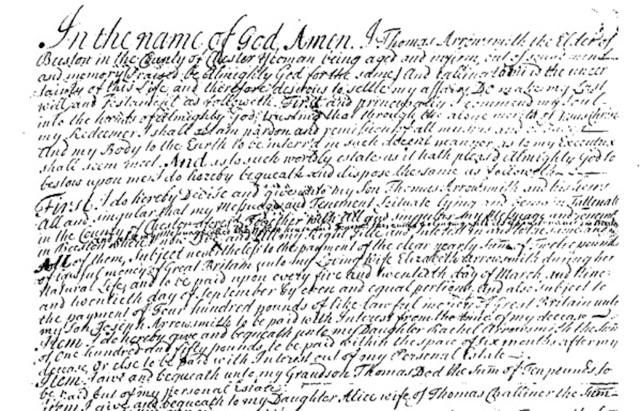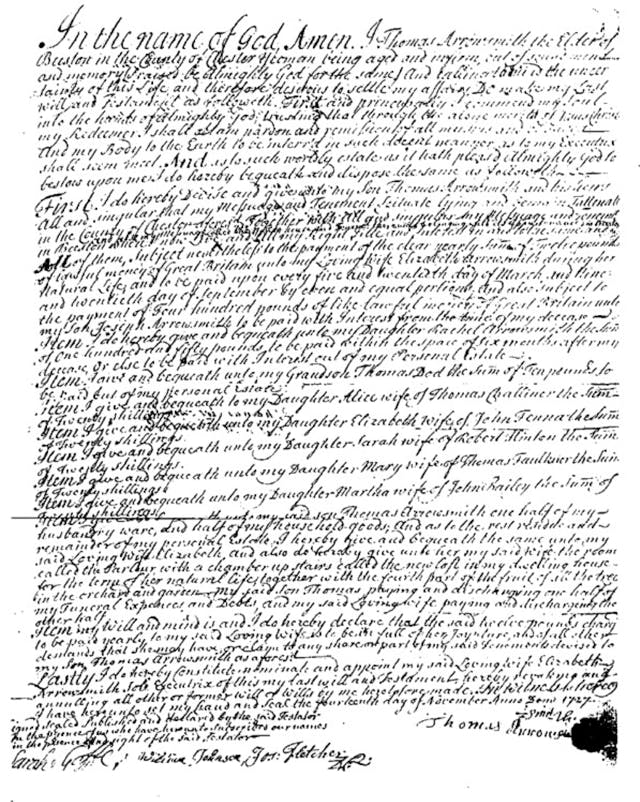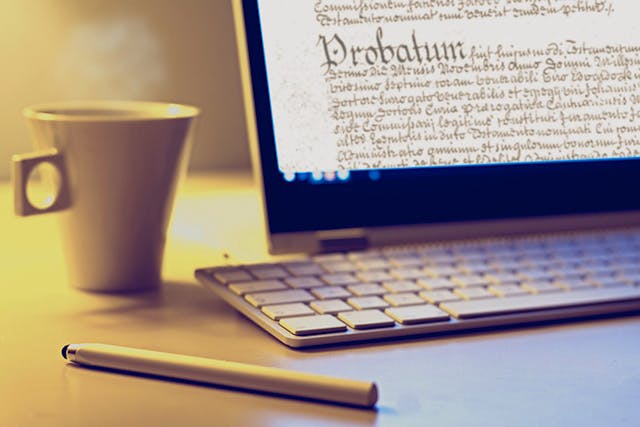
Palaeography Part 1: How to Create Abstracts from Old Documents
The handwriting used during the lives of our ancestors can be difficult to read and sometimes frustrating for the untrained eye.
Learning simple methodologies will help a researcher have a more enjoyable and fruitful experience with a document.

Study the letter forms
By having a working knowledge of the letter forms you will be reading, you will be more prepared and less frustrated when reading an actual document.
Try looking at the letters you can read (in the image above) and make a note of what letters are difficult. It reads: In the name of God, Amen.
Look at alphabet charts and try to familiarise yourself with letters that may be different than our modern versions.
Practice writing the letters to help familiarise you with how they are formed.

Learn about the document
Familiarise yourself with the language of the document type you are reading.
This important step will ultimately help you work out common phrases and individual words that are not in your everyday vocabulary.
The image above reads: bequeath, Tenement, Messuage, Executrix.

Have a dictionary near you, i.e. Oxford English Dictionary, with historical meanings of words (www.oed.com).
To the left is the will of Thomas Arrowsmith from Beeston, Cheshire. (Courtesy of the Cheshire Archives & Local Studies, Cheshire Archives and Local Studies)
At first glance, this italic hand may be difficult to read, or become overwhelming to the reader because of the amount of text or unknown vocabulary.
Let’s use this document as a guide to learn how to abstract important genealogical information from a document.
Abstract the Document
An abstract is basically a summary of the document created to help sort genealogical information.
Quickly run through the document at least one time and try to understand the document’s content. What is the subject? What were they trying to accomplish?
Create an abstract of the document to help you remember the content for future research.
When you have a hard time with specific names or phrases in the document, look back to the alphabet charts to help you.
Use references: make a note of a letter/word you don’t know, and use the rest of the document to compare the letters.
If there are some words you can’t understand with aids, ask a professional.
Example Abstract
Here is an example of an abstract created from the will of Thomas Arrowsmith from Beeston, Cheshire:
…unto my son THOMAS ARROWSMITH … my messuages [dwelling house, & outbuildings etc] … situate in Tattenhall Cheshire [and] in Beeston … subject to the payment of the clear yearly sum of £12 … unto my loving wife Elizabeth (executrix)
Son JOSEPH ARROWSMITH £400 (from brother)
Daughter RACHEL ARROWSMITH £150
Grandson THOMAS DOD £10
Daughter ALICE wife of THOMAS CHALLINER 20sh
Daughter ELIZABETH wife of JOHN FENNA 20sh
Daughter SARAH wife of ROBERT HINTON
Daughter MARY wife of Thomas FAULKNER 20sh
Daughter MARTHA wife of JOHN BAILY
Will dated 24 November 1727
Probate 7 December 1730 @ Consistory of Chester
Testator died 11 November 1730
Parts of a Good Abstract
- Note important genealogical information including names, dates, and relationships.
- Note important source information including the names, years, and places.
- Define words that you did not previously know.
- Create good source notes that can bring you back to the original document you used for your research.
- If needed, create a transcription of the document that will make it easier if ever revisited.
Parts of a Good Transcription
- Transcriptions are usually word by word, letter by letter, and follow a similar format to the original document.
- Use left and right brackets if you cannot transcribe a letter, word or phrase or to expand abbreviations for better comprehension. [ ]
- Use left and right brace to note if a word is rendered illegible by ink stains, rips, tears etc. { }
- Make sure each line of the transcription is numbered.
- Use the same punctuation present in the original document.
- If text was added to a row, use carets. ^ ^
Example Transcription
Here is an example of a (almost) complete transcription of the will of Thomas Arrowsmith from Beeston, Cheshire:
[1] In the name of God, Amen. I Thomas Arrowsmith the Elder of
[2] Beeston in the County of Chester Yeoman being aged and infirm, but of sound mind
[3] and memory (Praised be Almighty God for the same) And [c]alling to [ ] uncer
[4] tainty of this Life, and therfore desirous to settle my affairs. Do make my Last
[5] Will and Testament as followeth. First and principally I commend my Soul
[6] into the hands of Almighty God; trusting that through the above merits of Jesus Christ
[7] my Redeemer I shall obtain pardon and permission of all my sins and [ ]
[8] And my Body to the Earth to be interr’d in such decent manner as to my Executrix
[9] shall seem meet. And also such worldly estate as it hath pleas’d Almighty God to
[10] bestow upon me I do hereby bequeath and dispose the same as followeth - - -
[11] First I do hereby Devise and give unto my Son Thomas Arrowsmith and his heirs
[12] all and singular that my Messuage and Tenement scituate lying and being in Tullenale
[13] in the County of Chester afores[ai]d Together with all and singular my Messuage and Tenement
[14] in Beeston ^and also my messuage called the { } Tenem[en]t though belonging { }^ where now [ ]and Many Right Title and Interest In and [ ] me and
[15] All of them, Subject nevertheless to the payment of the clear yearly Sum[m] of two [ ]
[16] of lawful money of Great Britain unto my Loving Wife Elizabeth Arrowsmith during her
[17] Natural Life, and to be paid upon every five and twentieth day of March, and Nine
[18] and twentieth day of September by even and equal portions And also subject to
[19] the payment of Four hundred pounds of like lawful money of Great Britain unto
[20] my Son Joseph Arrowsmith to be paid with Interest from the time of my decease
[21] Item I do hereby give and bequeath unto my Daughter Rachel Arrowsmith the Sum[m]
[22] of One hundred and fifty pounds to be paid within the space of six months after my
[23] decease, Or else to be paid with Interest of of my Personal Estate-
[24] Item I give and bequeath unto my Grandson Thomas Dod the Sum[m] of Ten Pounds to
[25] be paid out of my personal Estate
[26] Item I give and bequeath to my Daughter Alice with of Thomas Calliner the Sum[m]
[27] of Twenty shillings.
[28] Item I give and bequeath unto my Daughter Sarah with of Robert Hinton the Sum[m]
[29] of Twenty shillings..
[30] Item I give and bequeath unto my Daughter Mary wife of Thomas Faulkner the Sum[m]
[31] of Twenty shillings.
[32] Item I give and bequeath unto my Daughter Martha wife of John Bailey the Sum[m] of
[33] Twenty shillings.
[34] Item I give and bequeath unto my said son Thomas Arrowsmith one halfe of my
[35] husbandry ware, and half of my household goods’ And as to the rest residue and
[36] remainder of my personal Estate I hereby give and bequeath the same to my
[37] said Loving Wife Elizabeth, and also do hereby give unto her my said Wife the room
[38] called the Parlour, with a chamber upstairs called the new loft in my dwelling house
[39] for the term of her natural life, together with the fourth part of the fruit of all the trees
[40] in the orchard and garden – My said Son Thomas paying and discharging one half of
[41] my Funeral Expences and Debts, and my said Loving wife paying and discharging one half of
[42] other half.
[43] Item my Will and mind is and I do hereby declare that the said twelve pounds charg
[44] to be paid yearly to my said Loving Wife is to be the full of her Joynture and of all other
[45] demands that she may have or claim to any share or part of my said tenements devised to
[46] any Son, Thomas Arrowsmith as afores[ai]d
[47] Lastly I do hereby Constitute nominate and appoint my said Loving Wife Elizabeth
[48] Arrowsmith Sole Eccutrix of this my last will and Testament, hereby revoking and
[49] annulling all other former will or wills by me heretofore made, In witness whereof
[50] I have hereunto set my hand and Seal the fourteenth day of November Anno Dom[ini] 1727.
[51] Signed Sealed Published and declared by the said Testator
[52] in the presence of us who have hereunto Subscribed our names Thomas Arrows{ }
[53] in the presence [ ] sight of the said Testator
[54] Sarah Cottle William Johnson Jo[hn] Fletcher
Join us
As a member, you can make the most of our resources, access our experts, and find a welcoming community of people interested in family history and genealogy.
We all have roots. Let’s find them together.
